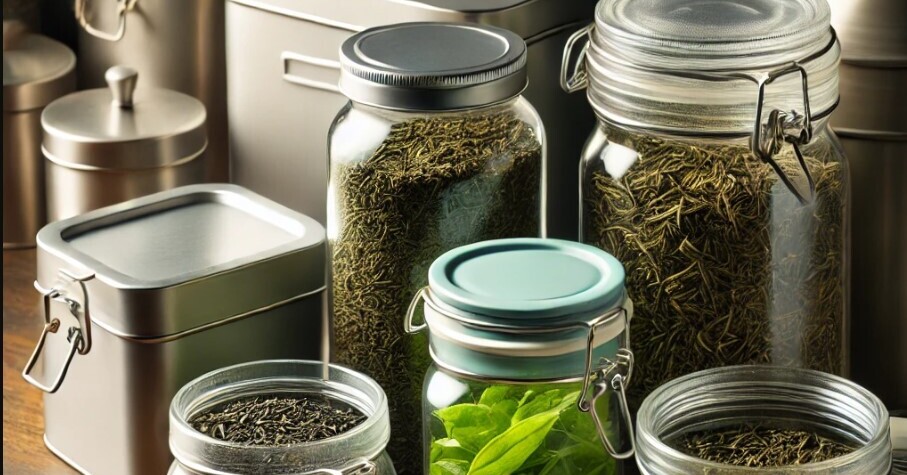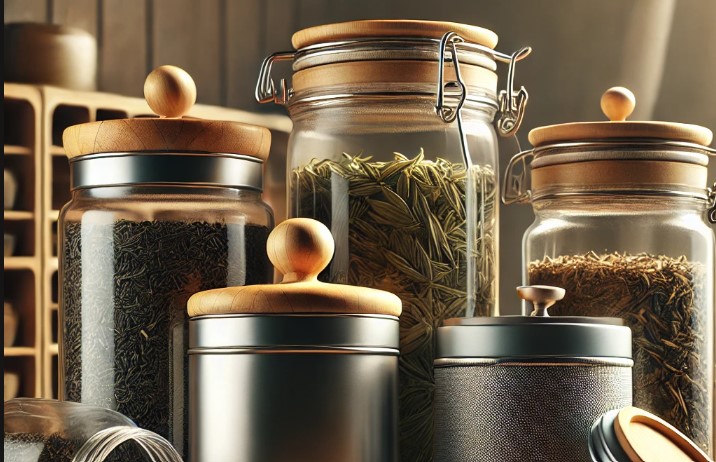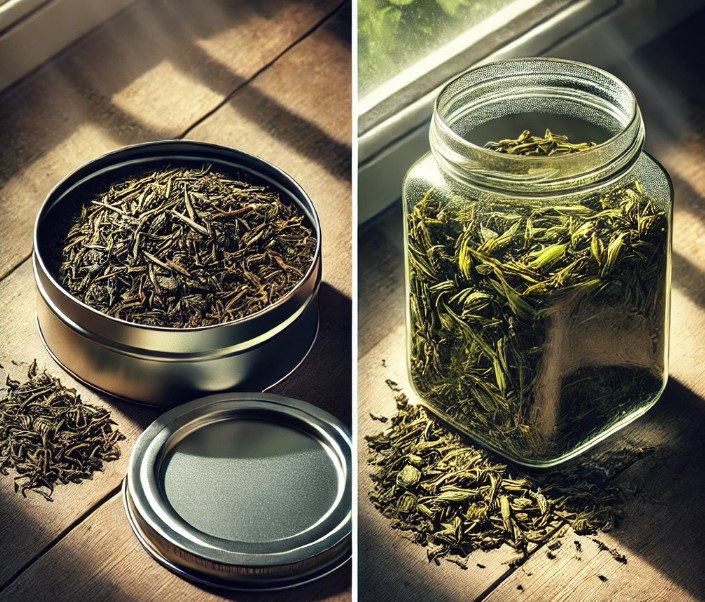
Ever found yourself sipping a cup of green tea that lacked that fresh, vibrant flavor you were hoping for? Chances are, poor storage might be the culprit. Storing green tea the right way preserves its unique taste and aroma. Keep it fresh, and you’ll be rewarded with each sip!
Why Proper Green Tea Storage Matters
The magic of green tea isn’t just about taste. It’s also rich in antioxidants that improve well-being. However, poor storage can mess with these benefits. Heat, light, and air can degrade the goodies that make green tea awesome, like catechins and vitamins.
Neglecting proper storage could mean you’re missing out on the full potential of your tea collection. By giving your green tea the love and care it needs, you’ll enjoy better taste, aroma, and a health boost. So, stash your tea like a pro and reap the benefits with each brew!
Choosing the Right Containers for Green Tea Storage
Picking the right container is crucial if you want to keep your green tea tasting fresh. Each option—glass, tin, ceramic, and plastic—has its own perks and pitfalls. Let’s see which one suits your needs the best!
1. Glass Containers
Glass jars are beautiful and allow you to showcase your tea collection. However, exposure to light can degrade the flavor and aroma of your tea over time. If you opt for glass, choose one with UV protection or store it in a dark place.
Best Glass Tea Storage Products:
- Anchor Hocking Montana Glass Jar with Lid – Has a tight-sealing lid and comes in various sizes.
- Le Parfait French Glass Jar with Rubber Seal – Airtight and stylish, ideal for small batches of tea stored away from light.
2. Tin Containers
Tea tins are widely used because they block both light and air, ensuring the tea remains fresh for a long time. However, a double-lid or silicone-sealed design is ideal to prevent air leakage.
Best Tin Tea Storage Products:
- Solstice Stainless Steel Tea Tin with Double Lid – Provides excellent protection from air, moisture, and light.
- Juxyes Tea Tins Canister with Airtight Double Lids – A budget-friendly option that is simple yet effective for tea storage.
3. Ceramic Containers
Ceramic is an excellent non-reactive material that keeps tea fresh, especially if the container has an airtight lid. It also prevents light exposure, making it one of the best choices for long-term storage.
Best Ceramic Tea Storage Products:
- Sweejar Kitchen Canisters Ceramic Storage Jar – Beautiful, airtight, and available in multiple colors.
- jessie Ceramic Storage Containers with Airtight Seal Bamboo Lids – A stylish and practical solution for preserving the freshness and aroma of your green tea.
4. Plastic Containers
Plastic is generally not recommended due to its tendency to absorb odors and potentially allow air to seep in. If you must use plastic, choose BPA-free, food-grade plastic with a strong airtight seal.
Best Plastic Tea Storage Option (if necessary):
- OXO Good Grips POP Container – Airtight but best used for short-term storage due to plastic odor absorption risks.

Should Green Tea Be Vacuum-Sealed?
For the best results, you might want to give vacuum-sealing a shot, especially if you’ve bought more tea than you can drink quickly! It can help extend green tea’s shelf life by removing air exposure, but it’s unnecessary for short-term storage. If vacuum-sealing, ensure the packaging is opaque and moisture-proof.
Tailoring Storage Methods for Different Green Tea Forms
Every type of green tea needs its own special kind of love when it comes to storage. Loose-leaf, bags, and that bright, vibrant matcha all play by different rules.
- Loose-Leaf Green Tea: Best Storage Practices
Loose-leaf green tea demands a bit of extra attention. It benefits most from airtight, dark containers. Peek-proof and air-tight keep the leaves crisp and ready to brew whenever you are. Keep it cool and dry, and your tea stays fresh for longer. - Green Tea Bags: Should You Refrigerate or Keep at Room Temperature?
Got green tea bags stashed in the pantry? You might wonder if they like it cool in the fridge. Truth is, they’re happiest at room temperature in a dark place, away from any strong smells. Fridge or pantry, go for whichever keeps them odor-free and sealed. - Matcha Powder: How to Prevent Clumping and Color Fading
When it comes to matcha, clumping and color fading are real threats. This finely ground powder thrives in airtight tins, specially designed to ward off light and air. If you’re using a big pack, think about portioning it out and storing small amounts for daily use. Keep it as fresh as that first vibrant green cup.
Each type deserves its own storage spotlight, catering to its unique needs. A bit of care and attention can keep all forms of green tea in their prime, so each cup is as perfect as the last.
Evaluating Refrigeration and Freezing for Green Tea
Ever been stumped by the idea of popping your green tea in the fridge? Well, it’s not always the straightforward win you might think it is. If you’re storing open powder or want to stash tea bags for a good while, refrigeration might extend freshness. Just be wary of any strong smells that might sneak into your tea.
Freezing Green Tea: Does It Help or Harm Freshness?
When it comes to freezing, it’s a bit of a tea storage mythbuster. Freezing can be a no-go if it leads to moisture build-up when thawed, which isn’t great for the tea’s quality. Yet, if you’ve got vacuum-sealed packets and plan to freeze for a long haul, it might do the trick without the thawing drama.
The fridge and freezer aren’t miracle workers. They can help, but only if used smartly. Look at your storage needs and the type of tea and pick the cold storage that won’t let you down. Long-term freshness is key, so make sure your tea emerges from storage as tasty and aromatic as ever.
Extending the Life of Green Tea: Best Practices
Green tea’s shelf life is a concern for any tea lover hoping to avoid sipping stale leaves. Different types of green tea vary in how long they last before losing their charm.
- Loose-Leaf Green Tea: 6–12 months if stored properly.
- Green Tea Bags: Typically up to 18 months.
- Matcha Powder: Best consumed within 6 months of opening.
How to Tell If Green Tea Has Gone Bad
Spotting if your green tea has gone bad isn’t rocket science. Look for faded colors, off-smells, or a change in taste that leaves you underwhelmed. If any of these happen, it’s probably past its prime. Brewing might bring the changes to light even more, so pay attention to any unwelcome surprises when you steep.
What About Storing Brewed Green Tea: Do’s and Don’ts
Brewed green tea has its own time clock ticking. While it won’t last indefinitely, a few hours at room temperature may be okay. However, it can start going sour or bitter if left out too long.
To avoid these surprises, keep it refrigerated if you’re planning to savor it over a few days. Reheating is fine, but don’t let it boil, or you might overheat those delicate flavors right out.
By mastering how long each form lasts and watching for those tell-tale signs of spoilage, you’ll keep each cup satisfying and flavorful. The goal is to enjoy every delightful note green tea offers without second-guessing its freshness.

Common Green Tea Storage Mistakes to Avoid
Why Exposure to Light, Air, and Moisture Ruins Tea
- UV light degrades tea compounds, making it taste stale.
- Oxygen exposure leads to oxidation, reducing potency.
- Moisture can cause mold and clumping.
How Green Tea Absorbs Odors from Other Foods
- Green tea easily absorbs surrounding smells, so keep it away from spices, coffee, and strong-smelling foods.
Additional FAQs About Green Tea Storage
Does Cold Green Tea Lose Its Benefits?
- Cold green tea retains most of its antioxidants if stored properly.
- Avoid storing for more than 24 hours to prevent bacterial growth.
Can You Store Green Tea in Plastic Containers?
- It’s best to avoid plastic due to odor absorption and potential chemical leaching.
- If using plastic, ensure it is BPA-free and airtight.
What Happens If Green Tea Isn’t Stored Properly?
- Improper storage leads to stale flavor, reduced potency, and potential spoilage.
- Exposure to moisture can cause mold growth, making it unsafe to consume.
By following these best practices, you can enjoy fresh, flavorful green tea with all its health benefits intact!
Conclusion: Sip Fresh, Stay Zen!
To enjoy green tea at its best, proper storage is key! By keeping your tea away from light, air, and moisture, choosing the right container, and avoiding common storage mistakes, you’ll ensure every sip is as fresh and flavorful as the first.
Now, it’s time to put this knowledge into action! Go check your tea stash—does it need a storage upgrade? If so, make those simple changes today and taste the difference in your next cup.
Do you have any green tea storage tips? Please share them in the comments below.

I really appreciated your deep dive into green tea storage it’s given me a lot to think about. I never realized how much light, air, and moisture can change the taste and health benefits of my tea. Your detailed breakdown of the best containers and storage methods made me reconsider how I’ve been storing my own tea stash. The point about green tea absorbing odors was especially eye-opening; it’s such a simple change that can make every cup taste as fresh as the first. Thanks for sharing these practical tips it’s inspiring me to keep my brew as vibrant and full of benefits as possible!